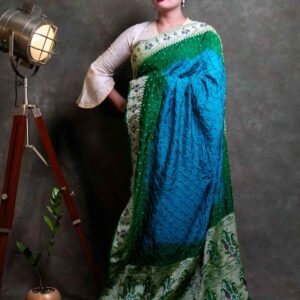Pure silk weaving is a traditional textile art form that involves the intricate process of transforming silk fibers into luxurious fabrics using handlooms or mechanized weaving machines. Here’s a detailed description:
The process of pure silk weaving begins with the cultivation of silk cocoons, usually from silkworms such as the mulberry silkworm. These cocoons are carefully harvested, and the silk filaments are extracted through a process called reeling.
Once the silk filaments have been reeled, they are spun together to create silk threads. These threads are then ready for the weaving process.
Weaving pure silk involves interlacing the silk threads together to form the fabric. This can be done using handlooms, where the weaver manually operates the loom to create the fabric, or mechanized weaving machines, which automate the process.
The weaving process allows for the creation of a variety of patterns, textures, and designs in the silk fabric. Traditional weaving techniques such as plain weave, satin weave, and twill weave are often used to create different effects in the fabric.
Pure silk weaving requires skill, precision, and attention to detail to ensure that the fabric is woven evenly and without flaws. Weavers may incorporate additional elements into the fabric, such as metallic threads (known as zari) or intricate designs, to enhance its beauty and value.
Once the weaving process is complete, the silk fabric undergoes finishing processes such as washing, steaming, and pressing to enhance its texture, luster, and drape.
The resulting pure silk fabric is prized for its softness, sheen, and luxurious feel. It is used to create a variety of garments and textiles, including sarees, scarves, dresses, and upholstery fabrics, and is cherished by connoisseurs of fine textiles for its beauty, craftsmanship, and cultural significance.









Reviews
There are no reviews yet.